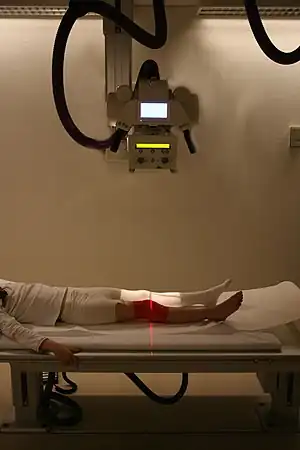Injury
| Injury | |
|---|---|
| Other names: Physical traum | |
 | |
| The knee of a person is examined with the help of radiography after an injury. | |
Injury, also known as physical trauma, is damage to the body caused by an external force.[1] This may be caused by accidents, falls, hits, weapons, and other causes.[1] Major trauma is injury that has the potential to cause prolonged disability or death. In 2013, 4.8 million people world-wide died from injuries, up from 4.3 million in 1990.[2] More than 30% of these deaths were transport-related injuries.[2] In 2013, 367,000 children under the age of five died from injuries, down from 766,000 in 1990.[2] Injuries are the cause of 9% of all deaths, and are the sixth-leading cause of death in the world.[3][4]
Classification


The World Health Organization (WHO) developed the International Classification of External Causes of Injury (ICECI). Under this system, injuries are classified by:
- mechanism of injury;
- objects/substances producing injury;
- place of occurrence;
- activity when injured;
- the role of human intent;
and additional modules. These codes allow the identification of distributions of injuries in specific populations and case identification for more detailed research on causes and preventive efforts.[5]
The United States Bureau of Labor Statistics developed the Occupational Injury and Illness Classification System (OIICS). Under this system injuries are classified by
- nature,
- part of body affected,
- source and secondary source, and
- event or exposure.
The OIICS was first published in 1992 and has been updated several times since.[6]
The Orchard Sports Injury and Illness Classification System (OSIICS), previously OSICS, is used to classify injuries to enable research into specific sports injuries.[7][8]
By cause
- Causes for injuries fall under two categories: intentional and accidental. Intentional injuries include acts of violence and war, or be can self-imposed like suicide or self-harm. Accidental injuries can come from falling or motor vehicle accidents.[9] Some cases of accidental injuries are injury by stingray or lightning injuries.
By modality
- Trauma
- Traumatic injuries are a body wound or shock produced by sudden physical collision or movement. Injuries associated with trauma are avulsion, bone fracture, injury by blast, internal bleeding and catastrophic injuries.
- Strain, repetitive strain, or sprain
- Strain and repetitive strain are injuries to muscles or tendons. Sprain is an injury to a ligament or ligaments.[10]
- Toxins
- Injury from toxin or as adverse effect of a pharmaceutical drug.
- Other external or internal injuries
- Other injuries can be from external causes, such as radiation, burn or frostbite. These injuries can include radiation-induced lung injury and microwave burn. Injuries from internal causes include reperfusion injury.
By location
Skin:
- Wound, an injury in which skin is torn, cut or punctured (an open wound), or where blunt force trauma causes a contusion (a closed wound). In pathology, it specifically refers to a sharp injury which damages the dermis of the skin.
Head:
Eyes:
- Nerve injury
- Spinal cord injury
- Brachial plexus injury
- Sciatic nerve injury
- Injury of axillary nerve
Soft tissue, musculoskeletal and organs:
- Soft tissue injury
- Tracheobronchial injury
- Acute kidney injury
- Anterior cruciate ligament injury
- Musculoskeletal injury
- Articular cartilage injuries
- Acute lung injury
- Pancreatic injury
- Thoracic aorta injury
- Biliary injury
Body:
By activity
- sports[11]
- rock climbing[12]
- finger injury
- knuckle injury
- Lead climbing injuries
- Reverse bite injury
- Occupational injury
- Ventilator-associated lung injury
- Sea urchin injury
- Illness and injuries during spaceflight
Injury severity score
The injury severity score (ISS) is a medical score to assess trauma severity.[13][14] It correlates with mortality, morbidity, and hospitalization time after trauma. It is used to define the term major trauma (polytrauma), recognized when the ISS is greater than 15.[14] The AIS Committee of the Association for the Advancement of Automotive Medicine designed and updates the scale.
See also
References
- 1 2 "Wounds and Injuries: MedlinePlus". Nlm.nih.gov. Archived from the original on 2016-07-05. Retrieved 2015-07-20.
- 1 2 3 GBD 2013 Mortality and Causes of Death, Collaborators (17 December 2014). "Global, regional, and national age-sex specific all-cause and cause-specific mortality for 240 causes of death, 1990-2013: a systematic analysis for the Global Burden of Disease Study 2013". Lancet. 385 (9963): 117–71. doi:10.1016/S0140-6736(14)61682-2. PMC 4340604. PMID 25530442.
- ↑ "The top 10 causes of death". Archived from the original on March 14, 2007. Retrieved 24 May 2015.
- ↑ Stein DM, Santucci RA (July 2015). "An update on urotrauma". Current Opinion in Urology. 25 (4): 323–30. doi:10.1097/MOU.0000000000000184. PMID 26049876. S2CID 26994715.
- ↑ "International Classification of External Causes of Injury (ICECI)". World Health Organization. Archived from the original on October 17, 2004. Retrieved 2014-03-24.
- ↑ "Occupational Injury and Illness Classification System". Centers for Disease Control and Prevention. Archived from the original on 2016-03-04. Retrieved 2014-03-24.
- ↑ Rae, K; Orchard, J (May 2007). "The Orchard Sports Injury Classification System (OSICS) version 10". Clin J Sport Med. 17 (3): 201–04. doi:10.1097/jsm.0b013e318059b536. PMID 17513912. S2CID 31994177. Archived from the original on 2018-12-30. Retrieved 2021-12-13.
- ↑ Orchard, JW; Meeuwisse, W; Derman, W; Hägglund, M; Soligard, T; Schwellnus, M; Bahr, R (April 2020). "Sport Medicine Diagnostic Coding System (SMDCS) and the Orchard Sports Injury and Illness Classification System (OSIICS): revised 2020 consensus versions". British Journal of Sports Medicine. 54 (7): 397–401. doi:10.1136/bjsports-2019-101921. PMID 32114487. S2CID 211724559.
- ↑ "Top 10 Preventable Injuries". Injury Facts. Archived from the original on 2020-10-20. Retrieved 2020-10-18.
- ↑ Nancy Garrick, Deputy Director (2017-04-10). "Sprains and Strains". National Institute of Arthritis and Musculoskeletal and Skin Diseases. Archived from the original on 2021-03-18. Retrieved 2020-10-18.
- ↑ "Top 10 Most Common Sports Injuries". www.unitypoint.org. Archived from the original on 2020-10-23. Retrieved 2020-10-19.
- ↑ Wright, D. M.; Royle, T. J.; Marshall, T. (June 2001). "Indoor rock climbing: who gets injured?". British Journal of Sports Medicine. 35 (3): 181–185. doi:10.1136/bjsm.35.3.181. ISSN 0306-3674. PMC 1724320. PMID 11375878.
- ↑ Baker SP, O'Neill B, Haddon W, Long WB (1974). "The Injury Severity Score: a method for describing patients with multiple injuries and evaluating emergency care". The Journal of Trauma. 14 (3): 187–96. doi:10.1097/00005373-197403000-00001. PMID 4814394.
- 1 2 Copes, W.S.; H.R. Champion; W.J. Sacco; M.M. Lawnick; S.L. Keast; L.W. Bain (1988). "The Injury Severity Score revisited". The Journal of Trauma. 28 (1): 69–77. doi:10.1097/00005373-198801000-00010. PMID 3123707.
External links
| Classification |
|---|
| Wikiquote has quotations related to: Injury |
- International Trauma Conferences Archived 2021-02-27 at the Wayback Machine (registered trauma charity providing trauma education for medical professionals worldwide)
- Trauma.org (trauma resources for medical professionals)
- Emergency Medicine Research and Perspectives (emergency medicine procedure videos)
- American Trauma Society Archived 2018-02-24 at the Wayback Machine
- Scandinavian Journal of Trauma, Resuscitation and Emergency Medicine Archived 2016-02-27 at the Wayback Machine
